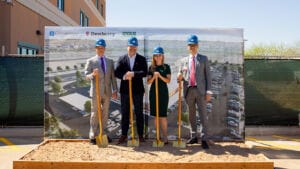Rising interest rates don’t appear to be stopping the big comeback in the Phoenix-area housing market. A new report from the W. P. Carey School of Business at Arizona State University reveals highlights for Maricopa and Pinal counties, as of June:
* The median single-family-home price rose again to $190,000, up about 27 percent from June of last year.
* The luxury market is finally booming back, now that more banks are willing to finance jumbo loans.
* Rising interest rates have caused some people to accelerate their housing purchases, not significantly slowed things down.
Phoenix-area home prices have risen dramatically since they hit a low point in September 2011. The median price for a single-family home went up 26.7 percent – from $150,000 to $190,000 – between June 2012 and this June. Realtors will note the average price per square foot jumped 21.1 percent over the same time. The median price for condominiums/townhomes went up 38.9 percent to $125,000.
The tight supply of homes available for sale continues to drive the upward price movement in the market, with multiple bids being offered for most resale homes in the lower price ranges. However, the luxury market is also roaring back, with sales higher this summer than for any of the last six years.
“Access to finance at the high end of the market has improved recently with more lenders offering jumbo loans,” says the report’s author, Mike Orr, director of the Center for Real Estate Theory and Practice at the W. P. Carey School of Business. “Along with good returns from the stock market, this has strengthened a recovery in the luxury market, where sales volumes were back to 2007 levels in June.”
Overall, the Phoenix-area market had 11,178 active single-family-home listings available without an existing contract as of July 1. However, about 84 percent of those were priced above $150,000, leaving just 26 days worth of inventory for buyers at the lower end of the market.
New-home builders aren’t completing houses fast enough to make a big dent in the supply problem. While analysts expected 17,000 construction permits to be issued this year, the area is only on track to have about 12,500.
“Current new-home sales rates are less than a third of what would normally be needed to keep up with the current population growth in the area,” says Orr. “Census estimates show that between 2010 and 2012, the combined population of Maricopa and Pinal counties grew by 2.9 percent, while the number of dwelling units – both owned and leased – grew by just 1 percent. Tight lending standards and a shortage of construction labor are two reasons for this.”
The Phoenix area is also seeing less cheap, “distressed” supply coming onto the market. Completed foreclosures on homes and condos in June were down 61 percent from last June. Foreclosure starts – owners receiving notice their lenders may foreclose in 90 days – were down 64 percent. Foreclosure starts finally just dipped back below “normal” historical levels for the area this June.
Institutional investors are showing less interest in the Valley as bargains are more readily available in other areas of the country. The percentage of Maricopa County homes and condos acquired by investors, including mostly “mom and pop” investors, was down from 34.9 percent last June to 26.7 percent this June. However, the area is still seeing a lot of all-cash home purchases. In fact, 44 percent of the Maricopa County property transactions under $150,000 were all-cash deals this June.
“For those who need mortgages, there has been much talk of rising interest rates and the effect this might have on demand,” adds Orr. “Rising rates have certainly reduced the motivation to refinance existing loans, but they have also sped up purchases by some buyers who want to lock in prices and rates. Still, other buyers will stop to reconsider their options, likely causing a pause in new contract signings in July and August, but I expect normal activity to resume in October.”
Rental activity remains strong, with relatively low vacancy rates and no surge in vacancies expected. Orr says the supply of rental homes in the Phoenix area represents just about two months of inventory, and there’s fast turnover.
“President Obama referred to his objective of making it easier for middle-class renters to qualify for home loans, when he visited Phoenix on Aug. 6,” says Orr. “The low-end market will depend to a considerable extent on whether he can make this happen through the actions of the Federal Housing Administration, Fannie Mae and Freddie Mac.”
Orr’s full report, including statistics, charts and a breakdown by different areas of the Valley, can be viewed at http://wpcarey.asu.edu/finance/real-estate/upload/Full-Report-201307.pdf. A podcast with more analysis from Orr is also available fromknowWPCarey, the business school’s online resource and newsletter, at http://knowwpcarey.com/index.cfm?cid=13.




